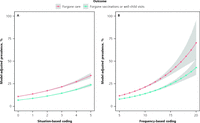Disparities in Unmet Health Care Needs Among US Children During the COVID-19 Pandemic
- PMID: 38527826
- PMCID: PMC11237210
- DOI: 10.1370/afm.3079
Disparities in Unmet Health Care Needs Among US Children During the COVID-19 Pandemic
Abstract
Purpose: The COVID-19 pandemic disrupted pediatric health care in the United States, and this disruption layered on existing barriers to health care. We sought to characterize disparities in unmet pediatric health care needs during this period.
Methods: We analyzed data from Wave 1 (October through November 2020) and Wave 2 (March through May 2021) of the COVID Experiences Survey, a national longitudinal survey delivered online or via telephone to parents of children aged 5 through 12 years using a probability-based sample representative of the US household population. We examined 3 indicators of unmet pediatric health care needs as outcomes: forgone care and forgone well-child visits during fall 2020 through spring 2021, and no well-child visit in the past year as of spring 2021. Multivariate models examined relationships of child-, parent-, household-, and county-level characteristics with these indicators, adjusting for child's age, sex, and race/ethnicity.
Results: On the basis of parent report, 16.3% of children aged 5 through 12 years had forgone care, 10.9% had forgone well-child visits, and 30.1% had no well-child visit in the past year. Adjusted analyses identified disparities in indicators of pediatric health care access by characteristics at the level of the child (eg, race/ethnicity, existing health conditions, mode of school instruction), parent (eg, childcare challenges), household (eg, income), and county (eg, urban-rural classification, availability of primary care physicians). Both child and parent experiences of racism were also associated with specific indicators of unmet health care needs.
Conclusions: Our findings highlight the need for continued research examining unmet health care needs and for continued efforts to optimize the clinical experience to be culturally inclusive.
Keywords: COVID-19; access to primary care; barriers; children’s health; health care disparities; health services accessibility; health services needs; pediatrics; preventive care; public health; racism; survey; unmet need; vaccination; vulnerable populations.
© 2024 Annals of Family Medicine, Inc.
Figures

References
MeSH terms
LinkOut - more resources
Full Text Sources
Medical
Miscellaneous
